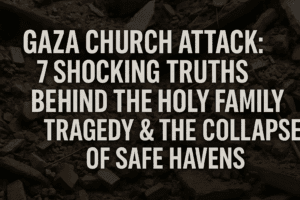Gaza Church Attack: 7 Shocking Truths Behind the Holy Family Tragedy & the Collapse of Safe Havens
The shelling of the Holy Family Church in Gaza, the only Catholic church in the Strip and a sanctuary for 500 displaced Christians, has shaken the already war-torn region to its core. The attack claimed three lives, wounded several—including parish priest Father Gabriel Romanelli—and destroyed the illusion that any place in Gaza remains safe. While the Israel Defense Forces called it a possible mistake, the Latin Patriarchate and Cardinal Pizzaballa expressed deep skepticism, stressing the sacred site’s explicit role as a civilian refuge.
The strike highlights a broader, harrowing reality: in Gaza, hospitals, homes, and now even churches no longer offer protection. This tragedy underscores the moral collapse that unfolds when civilian suffering becomes normalized, and places of worship become targets. Yet, Church leaders continue to affirm their commitment to stand by Gaza’s Christians, calling for global intervention. Their plea is not just religious—it’s a universal moral appeal to end a war they describe as “humanly and morally unjustified.”

Gaza Church Attack: 7 Shocking Truths Behind the Holy Family Tragedy & the Collapse of Safe Havens
The impact of a tank shell isn’t just measured in shattered concrete and broken glass. When it struck the Holy Family Church in Gaza this morning, it shattered something far more profound: the fragile illusion of sanctuary in a land consumed by violence. As the only Catholic church in the Gaza Strip, Holy Family wasn’t merely a place of worship; it had become a vital refuge for approximately 500 displaced Christians, a desperate last haven where families stripped of “homes, possessions, and dignity” prayed simply to be spared.
The attack claimed three lives and left others wounded, including the parish priest, Father Gabriel Romanelli. While initial reports suggested “no fatalities,” the Latin Patriarchate of Jerusalem later confirmed the heartbreaking toll. Cardinal Pierbattista Pizzaballa, speaking to Vatican News, described a scene of chaos and suffering: “There are four people seriously wounded, among these four, two are in very dramatic conditions and their lives are in serious danger.” Father Romanelli, thankfully, sustained lighter injuries.
The Israel Defense Forces (IDF) reportedly suggested the strike was a “mistake.” Cardinal Pizzaballa cautiously acknowledged this claim but emphasized, “we are not sure about this.” The stark reality remains: a sacred space explicitly housing hundreds of terrified civilians was hit. The Patriarchate’s subsequent statement cut through any potential abstraction: “The people in the Holy Family Compound are people who found in the Church a sanctuary—hoping that the horrors of war might at least spare their lives.”
This attack forces a confrontation with uncomfortable truths:
- The Erosion of Safe Havens: In conflicts where civilian infrastructure – homes, hospitals, schools – is repeatedly damaged or destroyed, places of worship often become de facto shelters, embodying a last shred of perceived safety. Targeting them, intentionally or not, signals a terrifying escalation where even these symbolic refuges offer no protection.
- The Human Cost Beyond the Headline: While the church attack is a specific, shocking incident, the Patriarchate was painfully clear: “However, this tragedy is not greater or more terrible than the many others that have befallen Gaza. Many other innocent civilians have also been harmed, displaced and killed. Death, suffering and destruction are everywhere.” This event is a stark microcosm of the wider, relentless suffering endured by Gazans daily.
- The Moral Imperative: The Patriarchate’s appeal transcends religious affiliation: “The time has come for leaders to raise their voices and to do all that is necessary in order to stop this tragedy which is humanly and morally unjustified.” It is a plea grounded in universal human dignity, demanding an end to the cycle of violence that consistently claims innocent lives, whether in a church, a hospital, or a family home.
Cardinal Pizzaballa’s vow, echoed by the Patriarchate, resonates with a quiet, determined humanity amidst the horror: “We will never leave them alone… We will continue to stand by the side of the community of Gaza and do all that is within our power to support them.”
The shelling of the Holy Family Church is more than a tragic incident; it’s a devastating symbol. It represents the violation of the last refuge, the extinguishing of hope for safety even within sacred walls, and the unbearable normalization of civilian suffering in Gaza. The call from Jerusalem isn’t just for condemnation of this single act, but for a resolute global effort to end what they term a “humanly and morally unjustified” war, paving the way for the immense task of restoring human dignity amidst the ruins. The true test lies not just in mourning this sanctuary lost, but in heeding the desperate cry to stop the violence that made its violation inevitable.
You must be logged in to post a comment.